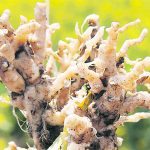
Made-in-Manitoba sunflower hybrid heads to market
Manitoba Crop Alliance lands U.S. co-operative CHS to commercialize the first confection sunflower variety to come out of their homegrown breeding program

Researchers chase resistance to bacterial leaf streak
Manitoba researchers are testing whether known resistance genes can be effective against bacterial leaf streak in cereal crops

RBC invests $5 million in Prairie sustainable agriculture
The new program, announced in Manitoba, links Prairie farmers, students and researchers with tools and training to promote sustainable agriculture

Sorting out the noise on fertilizer biologicals and biostimulants
With more companies entering the biologicals and biostimulant space, Prairie farmers are being urged to look past the hype and dig into the data

New soil treatment targets saline patches
New product, Crop Aid, focuses on water flow through the soil, offering an alternative to gypsum and organic ammendments

Cutting nitrogen in dry beans could pay off for farmers
Manitoba trials test whether farmers can apply less nitrogen to dry beans without losing yield, despite their typically poor nitrogen-fixing capacity

Verticillium may undermine canola blackleg resistance
Co-infections with verticillium stripe may compromise blackleg resistance protection in canola, new Manitoba research suggests

Soybeans, peas flag under Manitoba drought conditions
Manitoba’s lack of rain is stressing crops, fuelling pest pressure and slicing yield potential in soybean and pea fields

New seed labels proposed for canola clubroot resistance
Farmers may soon see a canola variety’s clubroot resistance broken down by pathotype on a new, more detailed seed label

Farmer-friendly nematodes: Tiny worms for big canola pest control
Soil-dwelling nematodes could become a practical option for Prairie pest control against damaging canola insect pests like diamondback moth


